Effect of Jointed Rock Mass on Seismic Response of Metro Station Tunnel-Group Structures
Abstract
:1. Introduction
2. Models: Design and Fabrication
2.1. Tunnel-Group Structures
2.2. Similitude Relations
2.3. Materials as Structural Lining and Rock Mass
2.4. Model Fabrication
3. Test Setup
3.1. Instrumentation
3.2. Inputs of Harmonic Excitation
4. Comparison between Two Models
4.1. Acceleration Responses of the Sites
4.1.1. Acceleration Time Histories of Ground Surfaces
4.1.2. Acceleration Amplification Factors along the Rock Height
4.2. Frequency Response of the Models
4.2.1. Transfer Function
- (1)
- The AAF at AS1 and AS2 fell within the range of the ground surface transfer functions, indicating the reliability of the similitude design and model fabrication, ensuring the comparability between the two models.
- (2)
- The spectral characteristics of the structures were controlled by the sites. This explains the observations in Figure 7a, where the excitation frequency of 23 Hz of the input case was close to the transverse fundamental frequency of 22.1 Hz for the HRM model; hence, the amplification effect was not significantly reduced.
- (3)
- It is worth noting that the presence of the station structure resulted in a slightly smaller amplitude of the ground surface transfer function (AS1) than the free field (AS2), which may be due to the station structures absorbing more input energy, leading to a smaller response at the top of the models. This coincides with the conclusion of the power spectral density analysis in Section 4.4.2 and is also verified in reference [35] regarding the effect of underground structures on the surface.
- (4)
- Compared to the HRM model, the JRM model had a significantly lower transverse fundamental frequency, while the longitudinal fundamental frequency remained essentially unchanged. This suggests that the transverse stiffness of the JRM model was reduced due to the influence of joints and discontinuous planes, while the longitudinal stiffness remained unchanged. The discontinuous plane at the top face of the JRM model in Figure 3b might be the primary reason for this. Meanwhile, the transverse fundamental frequency magnitude of the JRM model was 1.51 times that of the HRM model, possibly due to reflections and refractions of seismic waves caused by joints and discontinuous planes, enhancing the dynamic response at the ground surface.
- (5)
- Comparing the ground surface AS1 and AS2 within the same model, their transverse transfer function curves essentially coincided, with the fundamental frequency and magnitude being nearly identical, further proving that the AS2 location represents a “free field”. Similarly, the longitudinal transfer functions of AS1 and AS2 followed the same pattern.
4.2.2. Acceleration Power Spectral Density
4.3. Acceleration Responses of the Main Structures
4.3.1. Acceleration Time Histories of the Main Structures
4.3.2. Acceleration Amplification Factors
4.3.3. Arias Intensity
4.4. Dynamic Strain of the Station Structures
4.4.1. Dynamic Strain Time Histories at Structural Connections
4.4.2. Peak Tensile Strain at Structural Connections
4.4.3. Range of Tensile Strains at the Platform Connecting the Horizontal Passage
5. Conclusions
- (1)
- The adverse effects of joints and discontinuities on the site were quantified according to the elastic modulus formula of the jointed rock mass. Compared to the HRM model, the JRM model had a 22% reduction in the transverse fundamental frequency due to the effect of joints, but enhanced the dynamic response of the ground surface.
- (2)
- The presence of buried metro stations reduces the dynamic response of the ground surface. The closer the input frequency is to the model’s fundamental frequency, the more energy the underground structure consumes.
- (3)
- The HRM model and the JRM model produce different rock–structure dynamic interactions. Under a harmonic excitation of the same intensity, the JRM model produced a greater energy response to the station structure and reduced the acceleration response of the platform in the high-frequency region. The HRM model exhibited a greater seismic response under transverse excitation, while the JRM model showed a greater seismic response under longitudinal excitation.
- (4)
- For both models, greater tensile strains were generated at the connections of the main and subsidiary structures. The JRM model produced a peak tensile strain at the connections of the main and subsidiary structures that was 31% larger than that of the HRM model. In the JRM model, the range of tensile strains at the platform connecting the horizontal passage was approximately three times its span of the horizontal passage. Meanwhile, in the HRM model, the range of tensile strains at the platform connecting the horizontal passage was about twice its span of the horizontal passage.
Author Contributions
Funding
Institutional Review Board Statement
Informed Consent Statement
Data Availability Statement
Conflicts of Interest
Abbreviations
| JRM | Jointed rock mass |
| HRM | Homogeneous rock mass |
| AAF | Acceleration amplification factor |
| PSD | Power spectral density |
| FRF | Frequency response factor |
| IA | Arias intensity |
| EAF | Energy amplification factor |
| Symbols | |
| similitude ratios of acceleration | |
| similitude ratios of Young’s modulus | |
| similitude ratios of geometry | |
| similitude ratios of density | |
| inter-angle between the shear stress and the loading plane | |
| m | number of joint sets |
| λ | normal density |
| average radius of the joint sets | |
| h | residual shear stress ratio |
| ratio of the input frequency to the fundamental frequency of the model | |
| a(t) | earthquake acceleration time history |
| με | micro strain |
References
- Wang, W.L.; Wang, T.T.; Su, J.J.; Lin, C.H.; Seng, C.R.; Huang, T.H. Assessment of damage in mountain tunnels due to the Taiwan Chi-Chi Earthquake. Tunn. Undergr. Space Technol. 2001, 16, 133–150. [Google Scholar] [CrossRef]
- Wang, Z.; Gao, B.; Jiang, Y.; Yuan, S. Investigation and assessment on mountain tunnels and geotechnical damage after the Wenchuan earthquake. Sci. China Ser. E-Technol. Sci. 2009, 52, 546–558. [Google Scholar] [CrossRef]
- Shen, Y.; Gao, B.; Yang, X.; Tao, S. Seismic damage mechanism and dynamic deformation characteristic analysis of mountain tunnel after Wenchuan earthquake. Eng. Geol. 2014, 180, 85–98. [Google Scholar] [CrossRef]
- Yu, H.T.; Chen, J.T.; Yuan, Y.; Zhao, X. Seismic damage of mountain tunnels during the 5.12 Wenchuan earthquake. J. Mt. Sci. 2016, 13, 1958–1972. [Google Scholar] [CrossRef]
- Yu, H.; Chen, J.; Bobet, A.; Yuan, Y. Damage observation and assessment of the Longxi tunnel during the Wenchuan earthquake. Tunn. Undergr. Space Technol. 2016, 54, 102–116. [Google Scholar] [CrossRef]
- Wang, X.; Chen, J.; Xiao, M. Seismic damage assessment and mechanism analysis of underground powerhouse of the Yingxiuwan Hydropower Station under the Wenchuan earthquake. Soil. Dyn. Earthq. Eng. 2018, 113, 112–123. [Google Scholar] [CrossRef]
- Ardeshiri-Lajimi, S.; Yazdani, M.; Langroudi, A.A. Control of fault lay-out on seismic design of large underground caverns. Tunn. Undergr. Space Technol. 2015, 50, 305–316. [Google Scholar] [CrossRef]
- Wang, X.; Xiong, Q.; Zhou, H.; Chen, J.; Xiao, M. Three-dimensional (3D) dynamic finite element modeling of the effects of a geological fault on the seismic response of underground caverns. Tunn. Undergr. Space Technol. 2020, 96, 103210. [Google Scholar] [CrossRef]
- Shen, Y.S.; Wang, Z.Z.; Yu, J.; Zhang, X.; Gao, B. Shaking table test on flexible joints of mountain tunnels passing through normal fault. Tunn. Undergr. Space Technol. 2020, 98, 103299. [Google Scholar] [CrossRef]
- Gudmundsson, A. The propagation paths of fluid-driven fractures in layered and faulted rocks. Geol. Mag. 2022, 159, 1978–2001. [Google Scholar] [CrossRef]
- Price, N.J.; Cosgrove, J.W. Analysis of Geological Structures; Cambridge University Press: Cambridge, UK, 1990. [Google Scholar]
- Singhal, B.B.S.; Gupta, R.P. Applied Hydrogeology of Fractured Rocks; Springer Science & Business Media: Berlin/Heidelberg, Germany, 2010. [Google Scholar] [CrossRef]
- Byun, J.H.; Lee, J.S.; Park, K.; Yoon, H.K. Prediction of crack density in porous-cracked rocks from elastic wave velocities. J. Appl. Geophys. 2015, 115, 110–119. [Google Scholar] [CrossRef]
- Deere, D. The rock quality designation (RQD) index in practice. In Rock Classification Systems for Engineering Purposes; ASTM International: Cincinnati, OH, USA, 1988. [Google Scholar] [CrossRef]
- Zhang, Q.; Huang, X.; Zhu, H.; Li, J. Quantitative assessments of the correlations between rock mass rating (RMR) and geological strength index (GSI). Tunn. Undergr. Space Technol. 2019, 83, 73–81. [Google Scholar] [CrossRef]
- Palmstrom, A.; Broch, E. Use and misuse of rock mass classification systems with particular reference to the Q-system. Tunn. Undergr. Space Technol. 2006, 21, 575–593. [Google Scholar] [CrossRef]
- Kausel, E. Early history of soil–structure interaction. Soil. Dyn. Earthq. Eng. 2010, 30, 822–832. [Google Scholar] [CrossRef]
- Anand, V.; Kumar, S.S. Seismic soil-structure interaction: A state-of-the-art review. Structures 2018, 16, 317–326. [Google Scholar] [CrossRef]
- Chen, J.; Yuan, Y.; Yu, H. Dynamic response of segmental lining tunnel. Geotech. Test. J. 2020, 43, 660–682. [Google Scholar] [CrossRef]
- Chen, J.; Yu, H.; Bobet, A.; Yuan, Y. Shaking table tests of transition tunnel connecting TBM and drill-and-blast tunnels. Tunn. Undergr. Space Technol. 2020, 96, 103197. [Google Scholar] [CrossRef]
- Zhao, X.; Li, R.; Yuan, Y.; Yu, H.; Zhao, M.; Huang, J. Shaking table tests on fault-crossing tunnels and aseismic effect of grouting. Tunn. Undergr. Space Technol. 2022, 125, 104511. [Google Scholar] [CrossRef]
- Li, R.; Yuan, Y.; Zhao, X.; Bilotta, E.; Huang, J. Local Site Effect of Fault Site and Its Impact on Seismic Response of Fault-Crossing Tunnel. J. Earthq. Eng. 2024, 1–19. [Google Scholar] [CrossRef]
- Li, S.; Cudmani, R.; Xiao, M.; Guo, Z.; Yuan, Y. Ground motion amplification pattern with TBM tunnels crossing soil-rock interface: Shaking table test. Undergr. Space 2023, 12, 202–217. [Google Scholar] [CrossRef]
- Yuan, Y.; Li, S.; Yu, H.; Xiao, M.; Li, R.; Li, R. Local site effect of soil-rock ground: 1-g shaking table test. Bull. Earthq. Eng. 2023, 21, 3251–3272. [Google Scholar] [CrossRef]
- Yoo, J.K.; Park, J.S.; Park, D.; Lee, S.W. Seismic response of circular tunnels in jointed rock. KSCE J. Civ. Eng. 2018, 22, 1121–1129. [Google Scholar] [CrossRef]
- Varma, M.; Maji, V.B.; Boominathan, A. Numerical modeling of a tunnel in jointed rocks subjected to seismic loading. Undergr. Space 2019, 4, 133–146. [Google Scholar] [CrossRef]
- Huang, J.; Zhao, M.; Xu, C.; Du, X.; Jin, L.; Zhao, X. Seismic stability of jointed rock slopes under obliquely incident earthquake waves. Earthq. Eng. Eng. Vib. 2018, 17, 527–539. [Google Scholar] [CrossRef]
- Ghosh, A.; Hsiung, S.M.; Chowdhury, A.H. Seismic Response of Rock Joints and Jointed Rock Mass: Center for Nuclear Waste Regulatory Analysis; NUREG/CR-6388 CNRWA 95-013; Engineering, Environmental Science, Geology: College Station, TX, USA, 1996. [Google Scholar]
- Li, R.; Yuan, Y. Seismic Response of Tunnel-group Metro Station in a Rock Site. In Civil-Comp Conferences, Proceedings of the Seventeenth International Conference on Civil, Structural and Environmental Engineering Computing, Pécs, Hungary, 28–31 August 2023; Civil-Comp Press: Edinburgh, UK, 2023. [Google Scholar]
- Yan, X.; Yu, H.; Yuan, Y.; Yuan, J. Multi-point shaking table test of the free field under non-uniform earthquake excitation. Soils Found. 2015, 55, 985–1000. [Google Scholar] [CrossRef]
- Wu, F.; Deng, Y.; Wu, J.; Li, B.; Sha, P.; Guan, S.; Zhang, K.; He, K.; Liu, H.; Qiu, S. Stress–strain relationship in elastic stage of fractured rock mass. Eng. Geol. 2020, 268, 105498. [Google Scholar] [CrossRef]
- Wu, F.Q.; Wang, S.J. A stress–strain relation for jointed rock masses. Int. J. Rock Mech. Min. 2001, 38, 591–598. [Google Scholar] [CrossRef]
- Brennan, A.J.; Thusyanthan, N.I.; Madabhushi, S.P. Evaluation of shear modulus and damping in dynamic centrifuge tests. J. Geotech. Geoenviron. 2005, 131, 1488–1497. [Google Scholar] [CrossRef]
- Zhang, J.; Yuan, Y.; Yu, H. Shaking table tests on discrepant responses of shaft-tunnel junction in soft soil under transverse excitations. Soil Dyn. Earthq. Eng. 2019, 120, 345–359. [Google Scholar] [CrossRef]
- Yuan, Y.; Yang, Y.; Zhang, S.; Yu, H.; Sun, J. A benchmark 1 g shaking table test of shallow segmental mini-tunnel in sand. Bull. Earthq. Eng. 2020, 18, 5383–5412. [Google Scholar] [CrossRef]
- Welch, P. The use of fast Fourier transform for the estimation of power spectra: A method based on time averaging over short, modified periodograms. IEEE Trans. Audio Electroacoust. 1967, 15, 70–73. [Google Scholar] [CrossRef]
- Yang, Y.; Zhang, S.; Zhang, J.; Yuan, Y.; Li, C.; Yu, H. Effect of excitation frequency on segmental tunnels in sand using 1 g shaking table tests. Transp. Geotech. 2022, 34, 100750. [Google Scholar] [CrossRef]

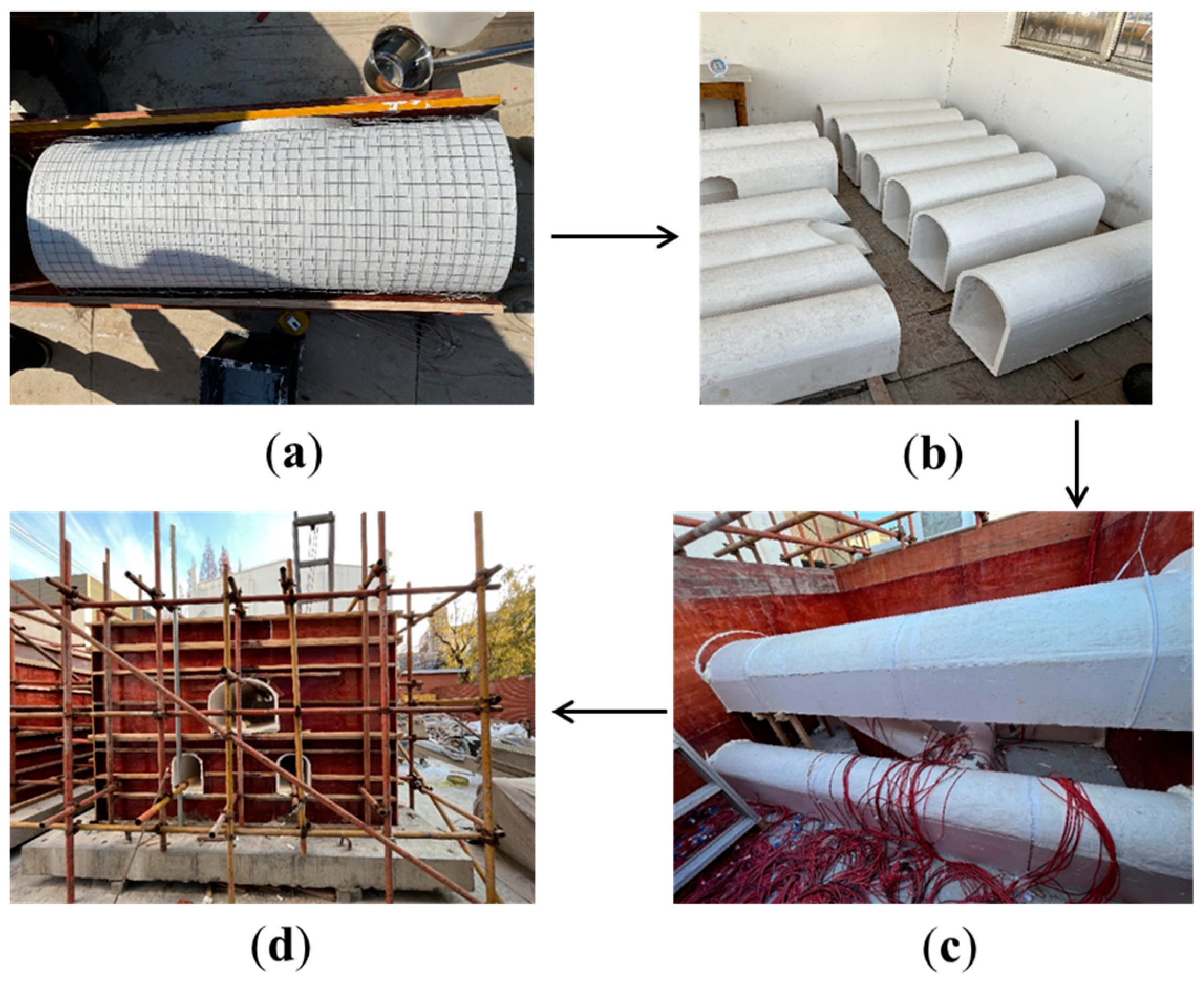
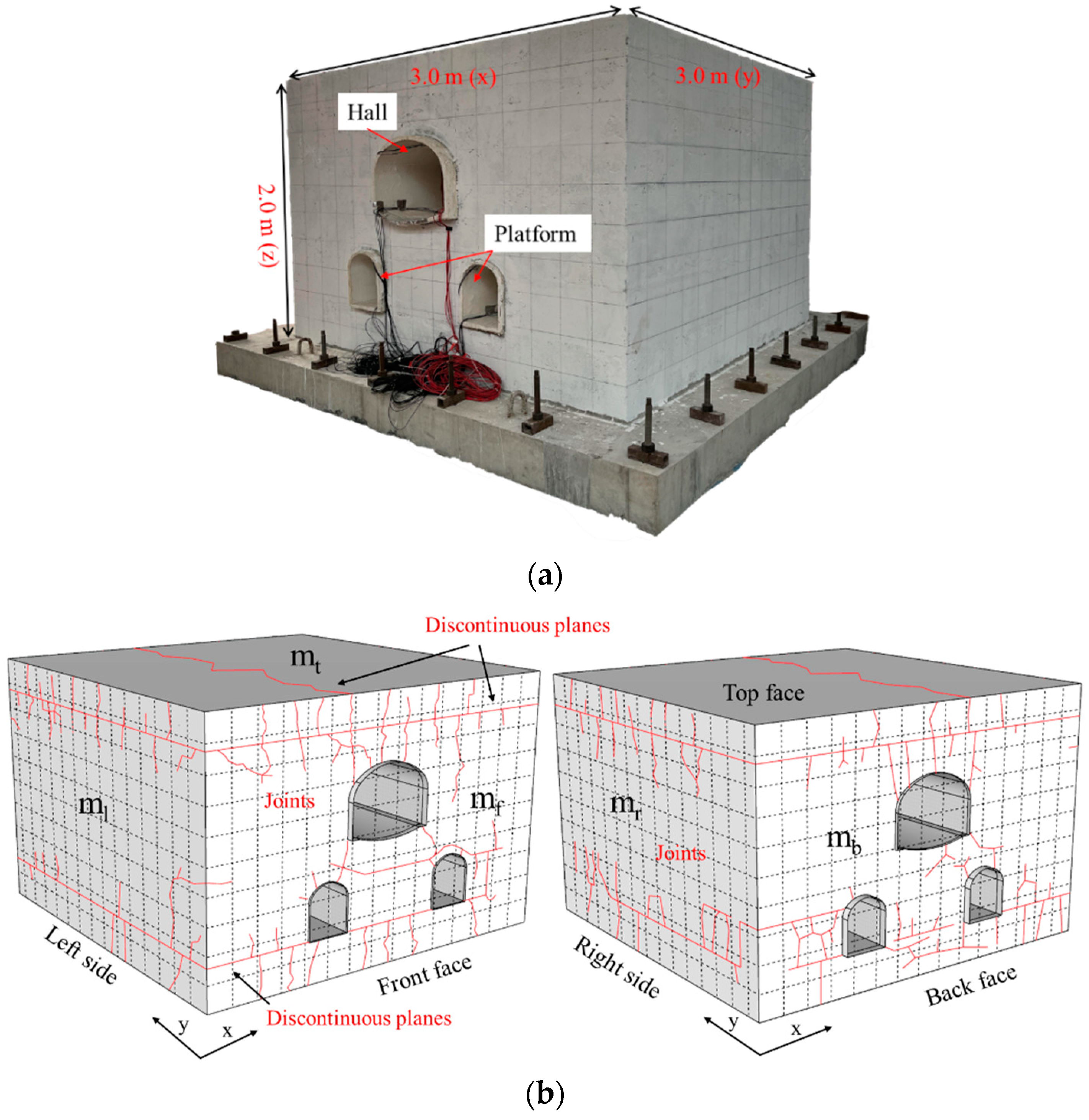

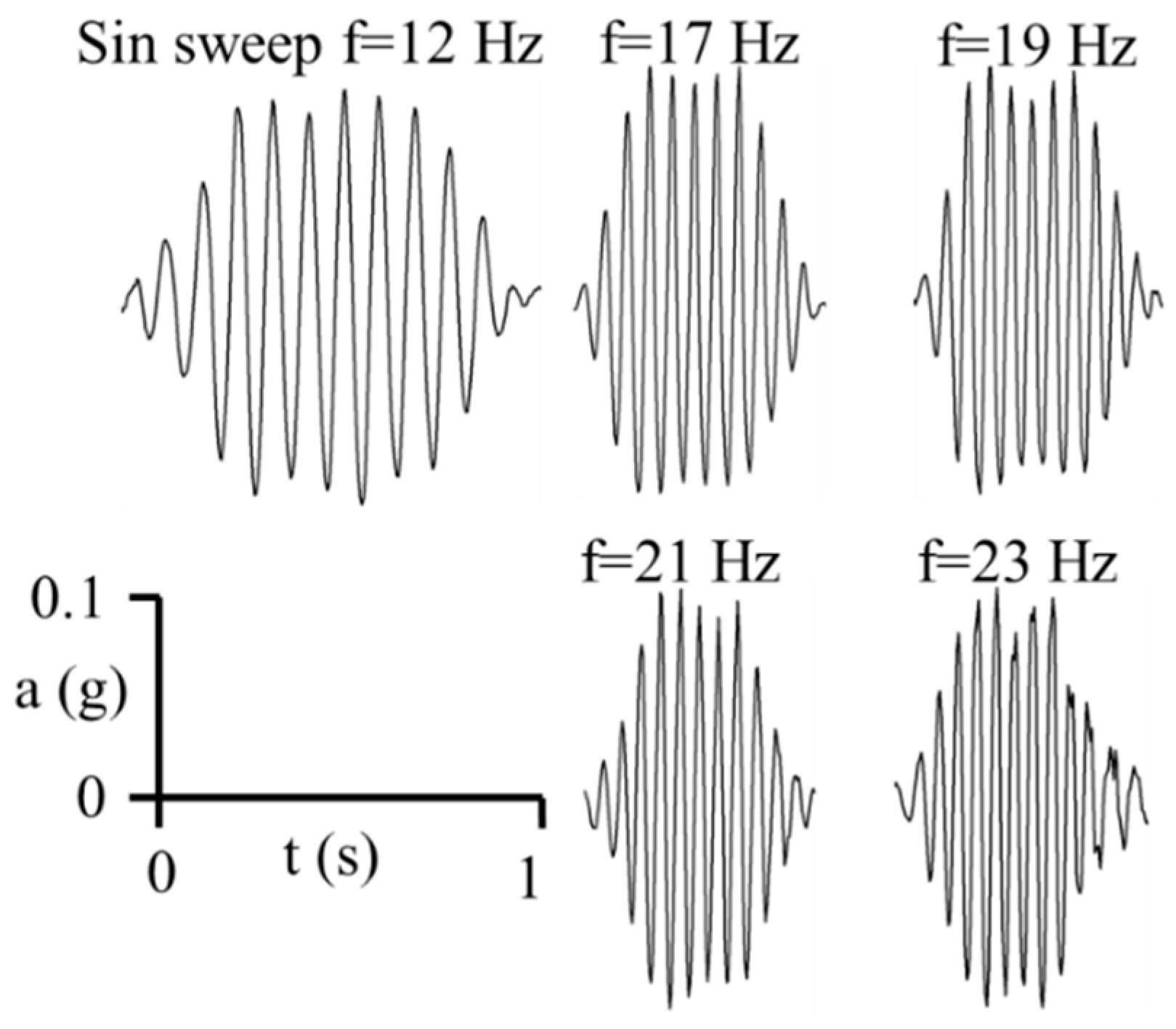
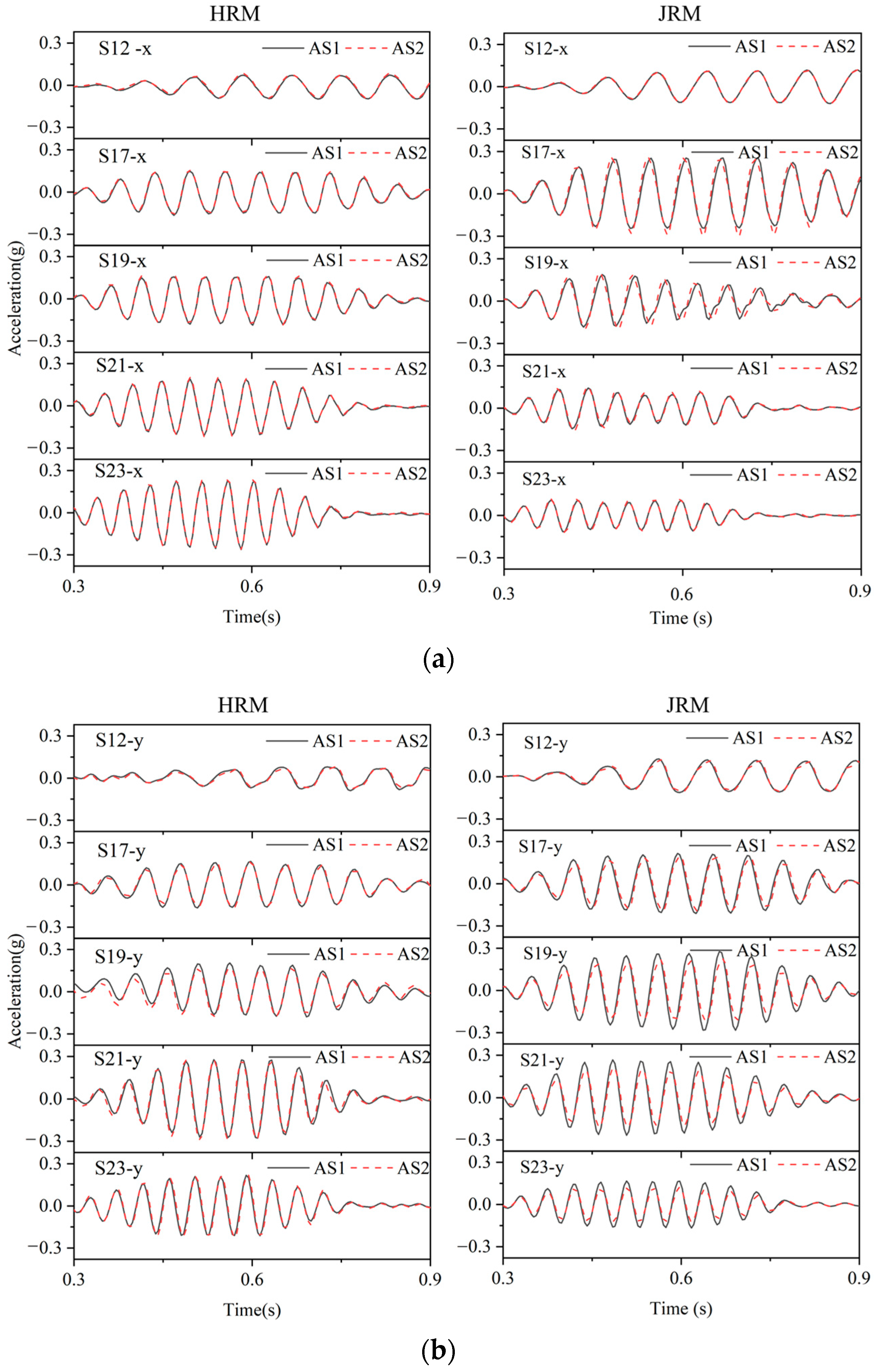
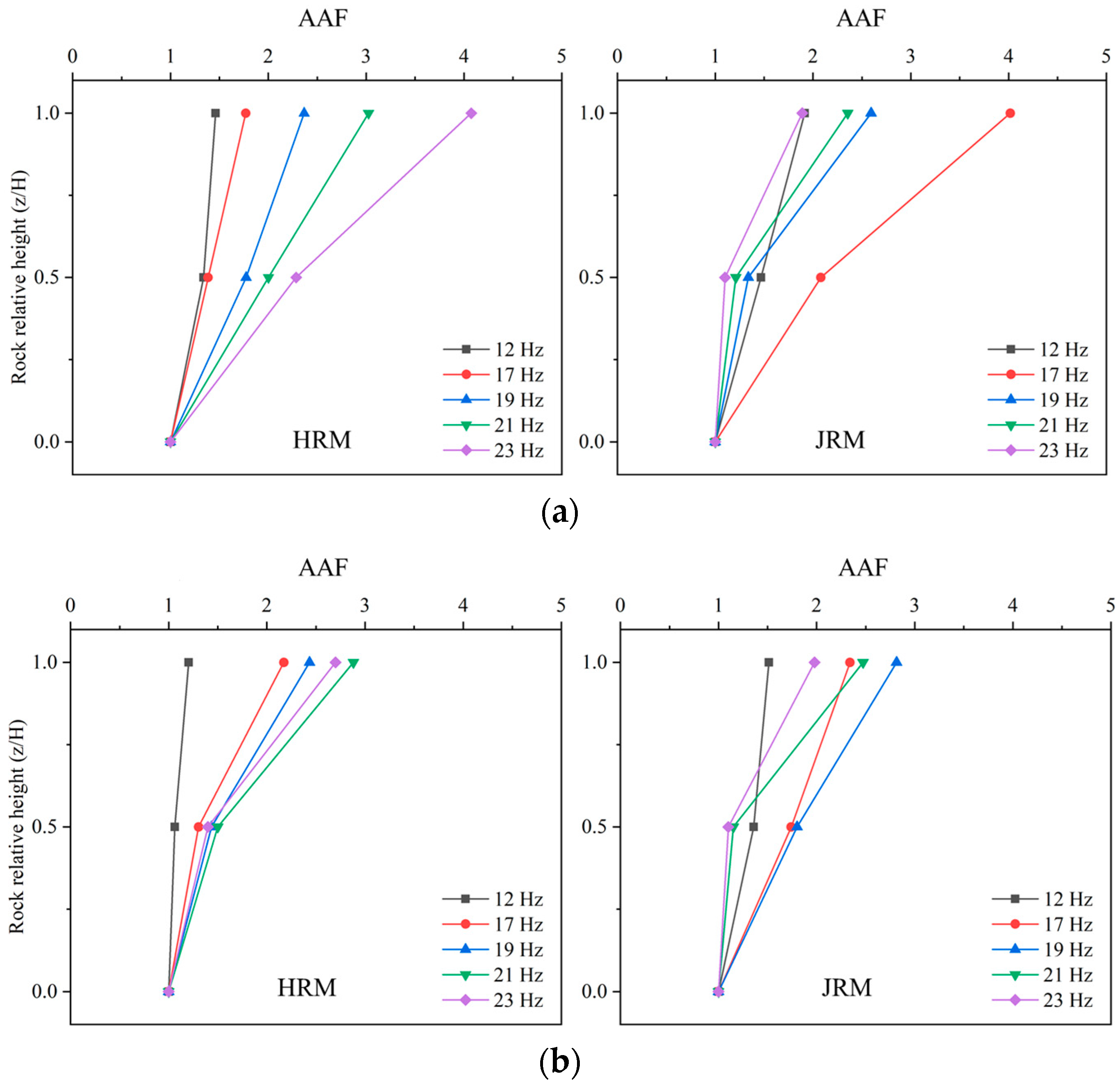


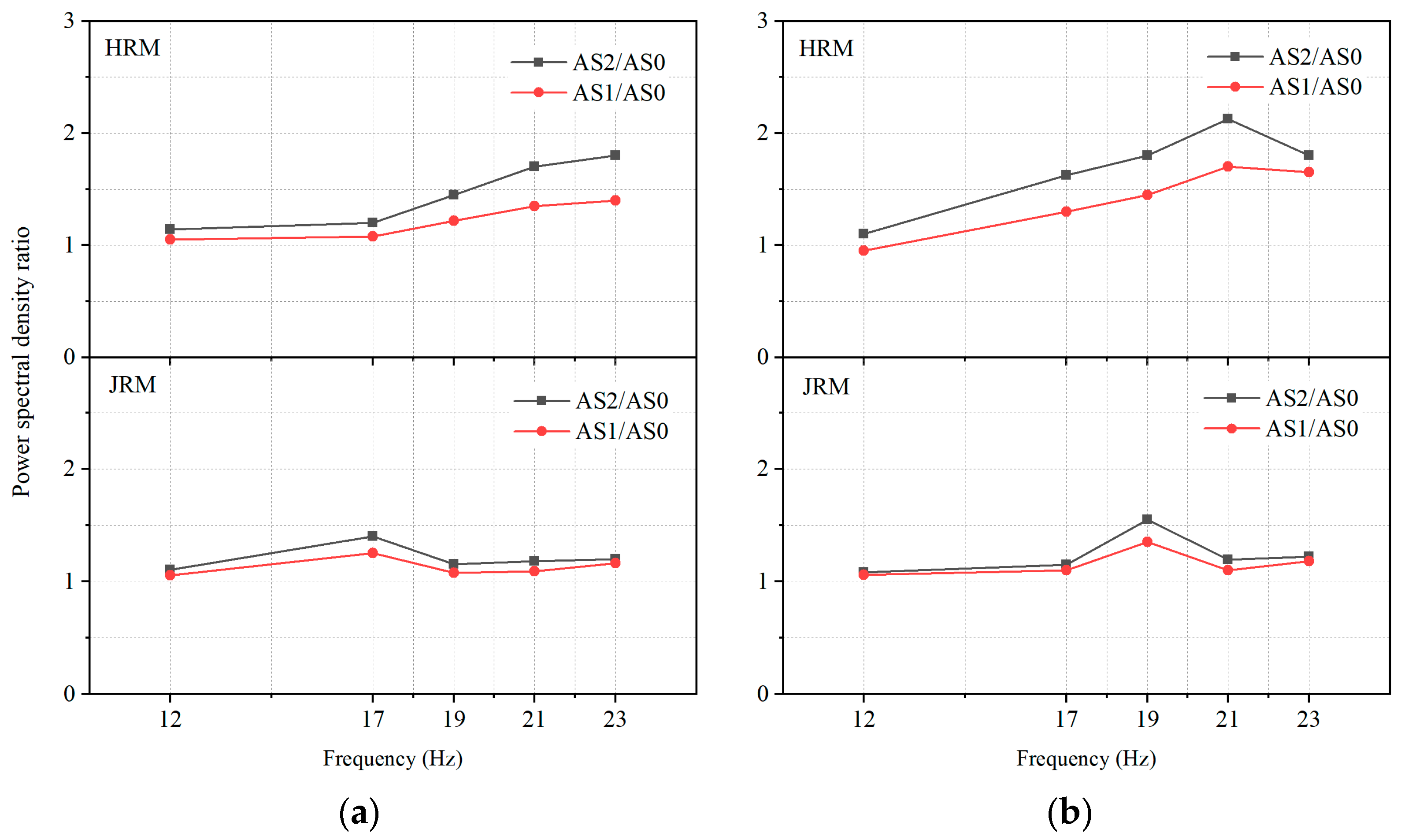
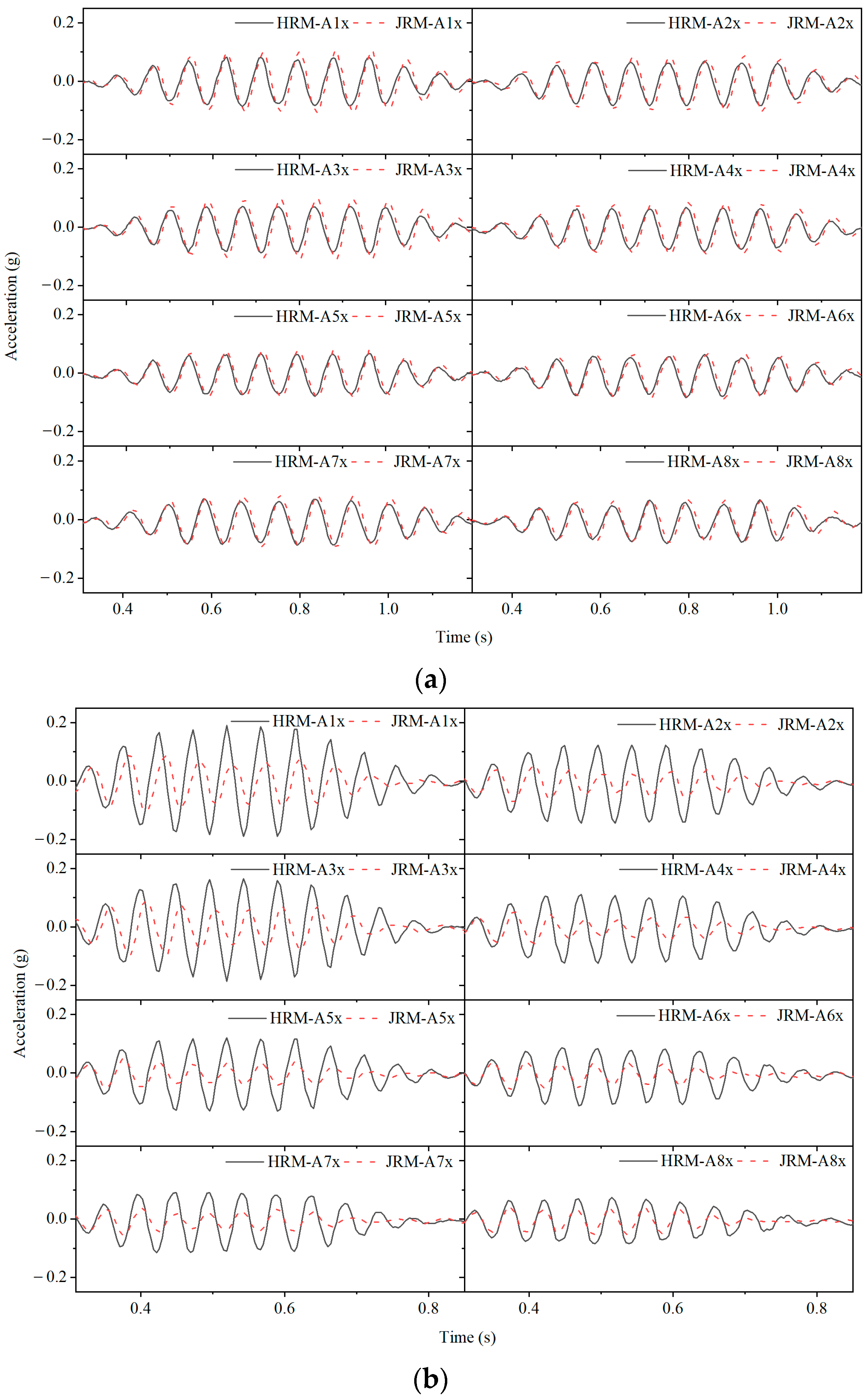
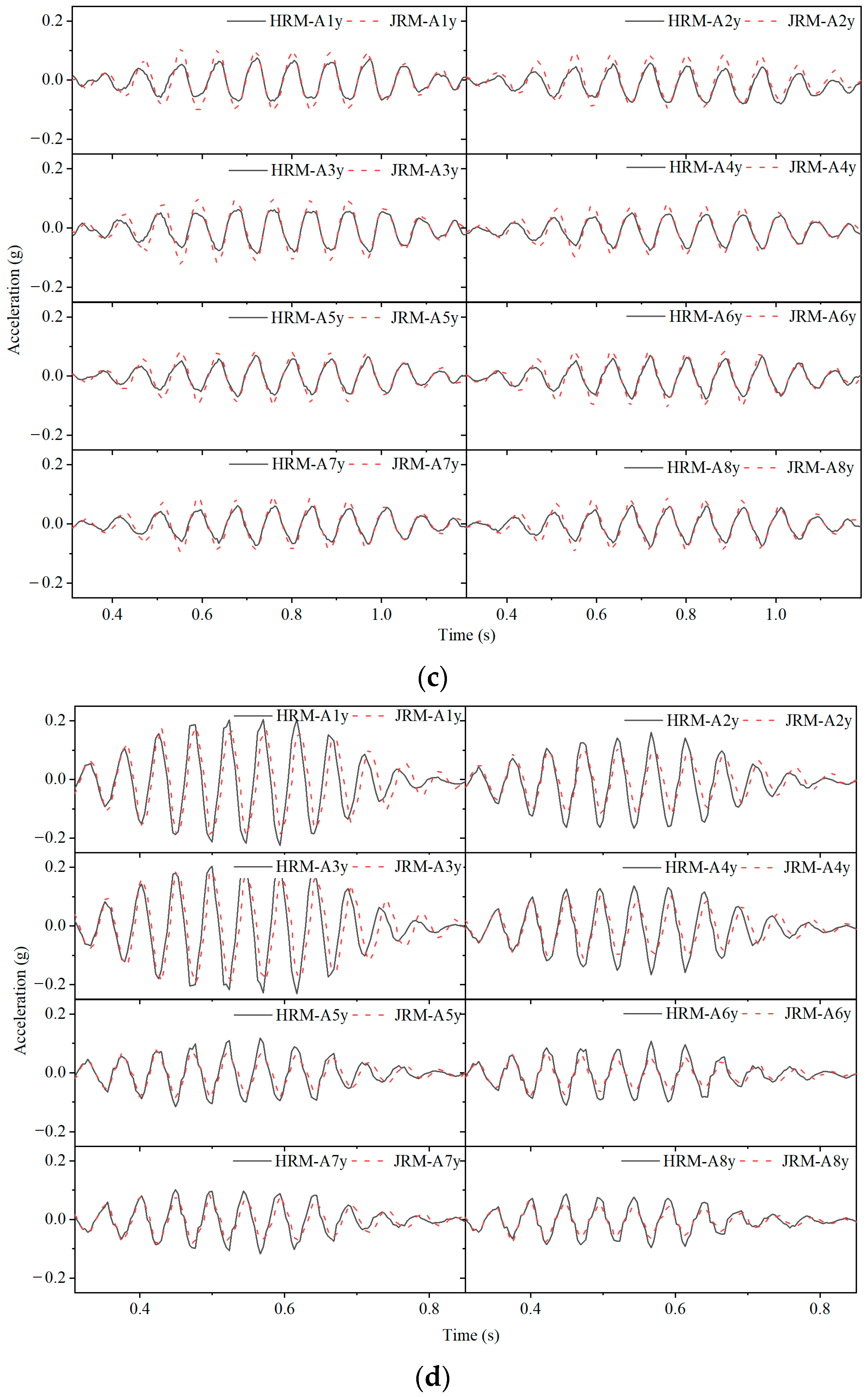
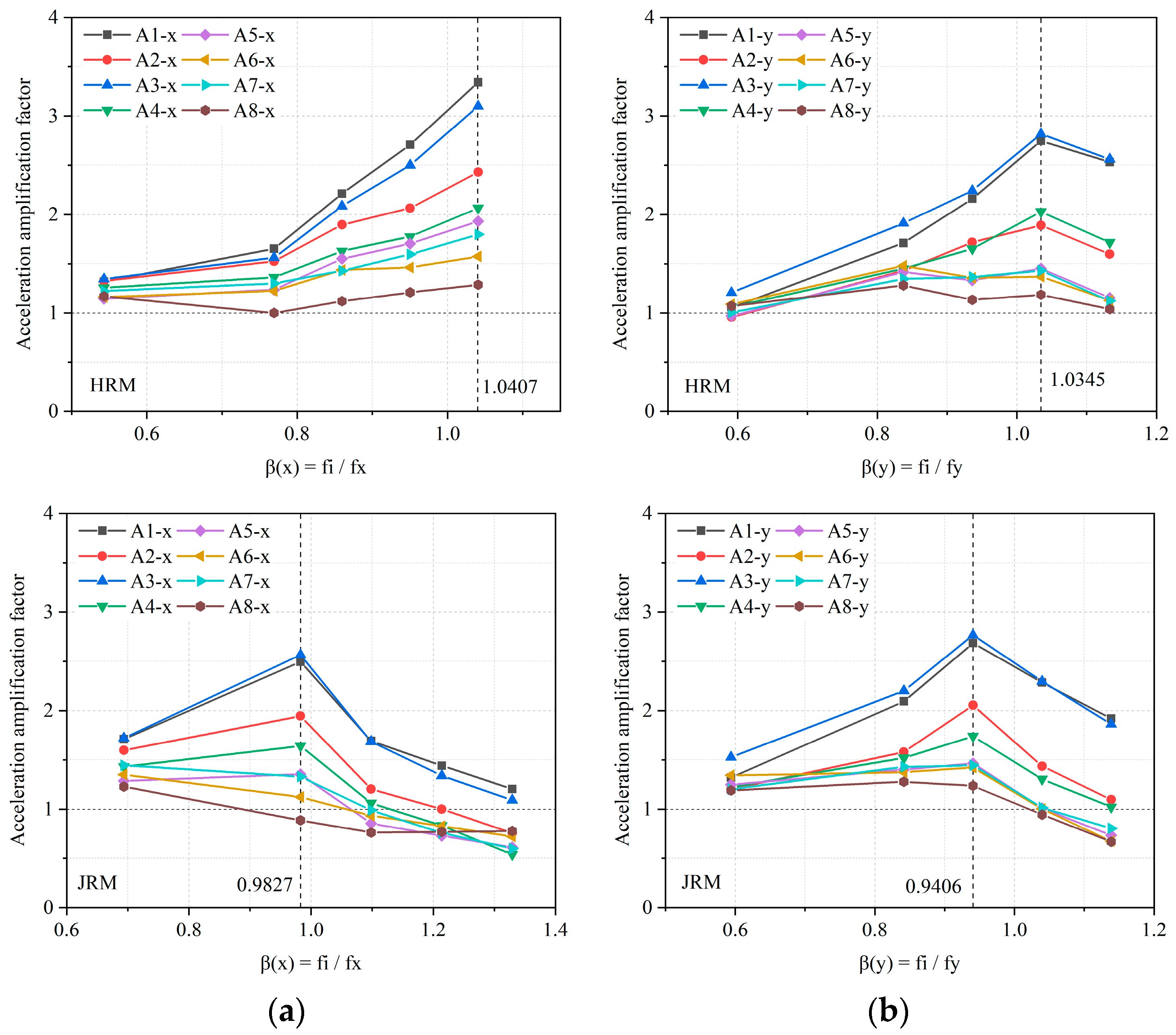

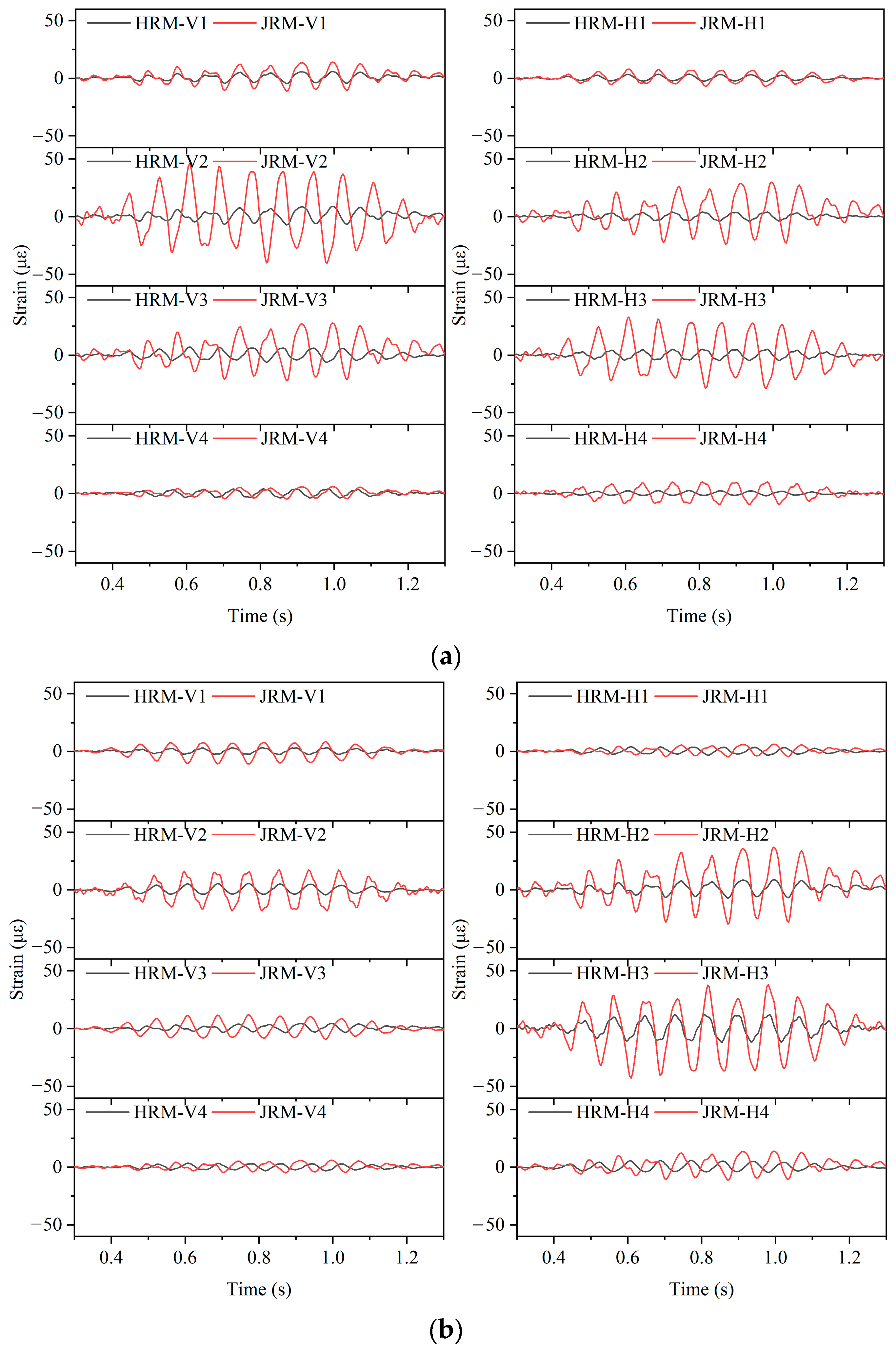
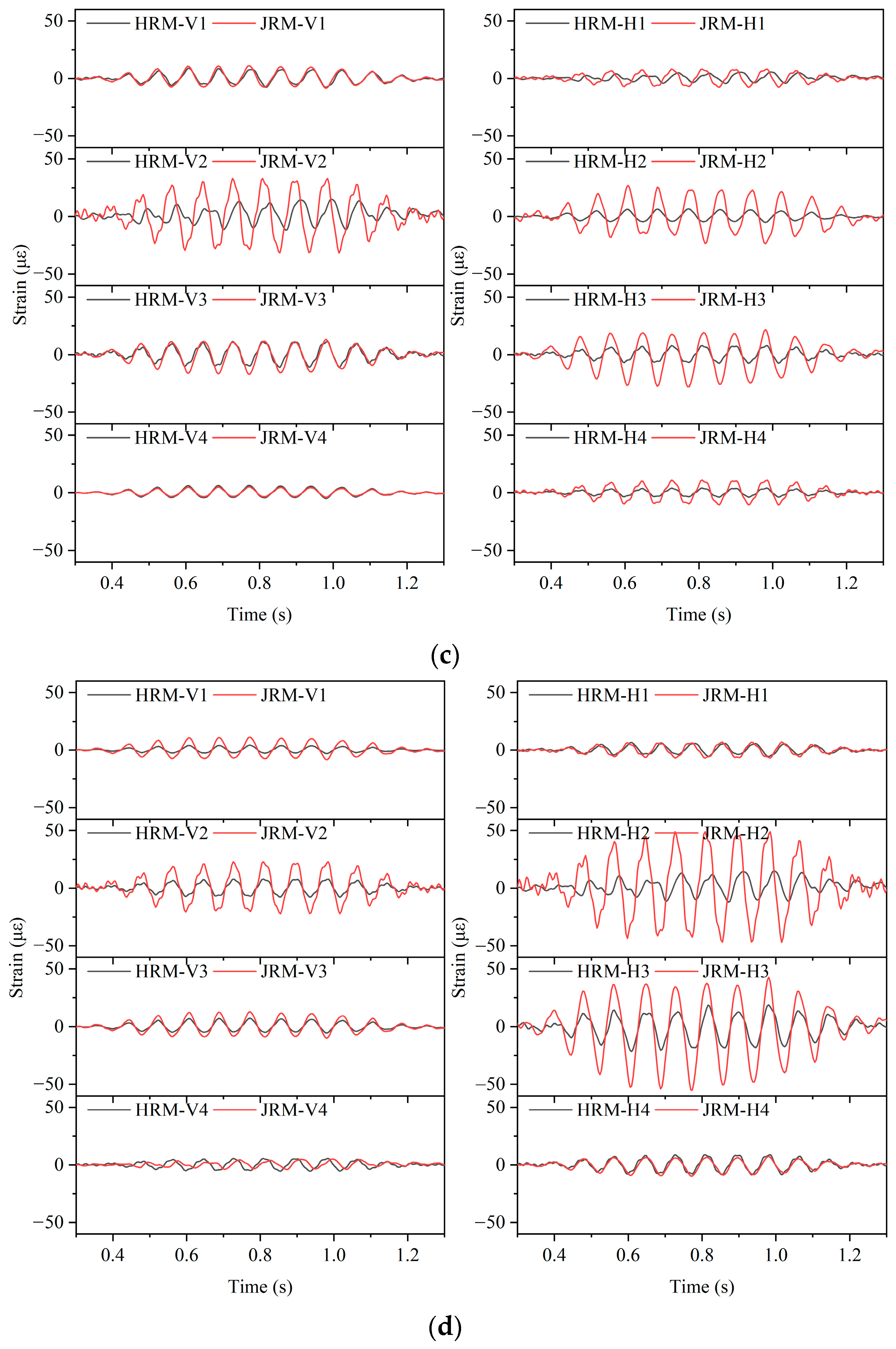
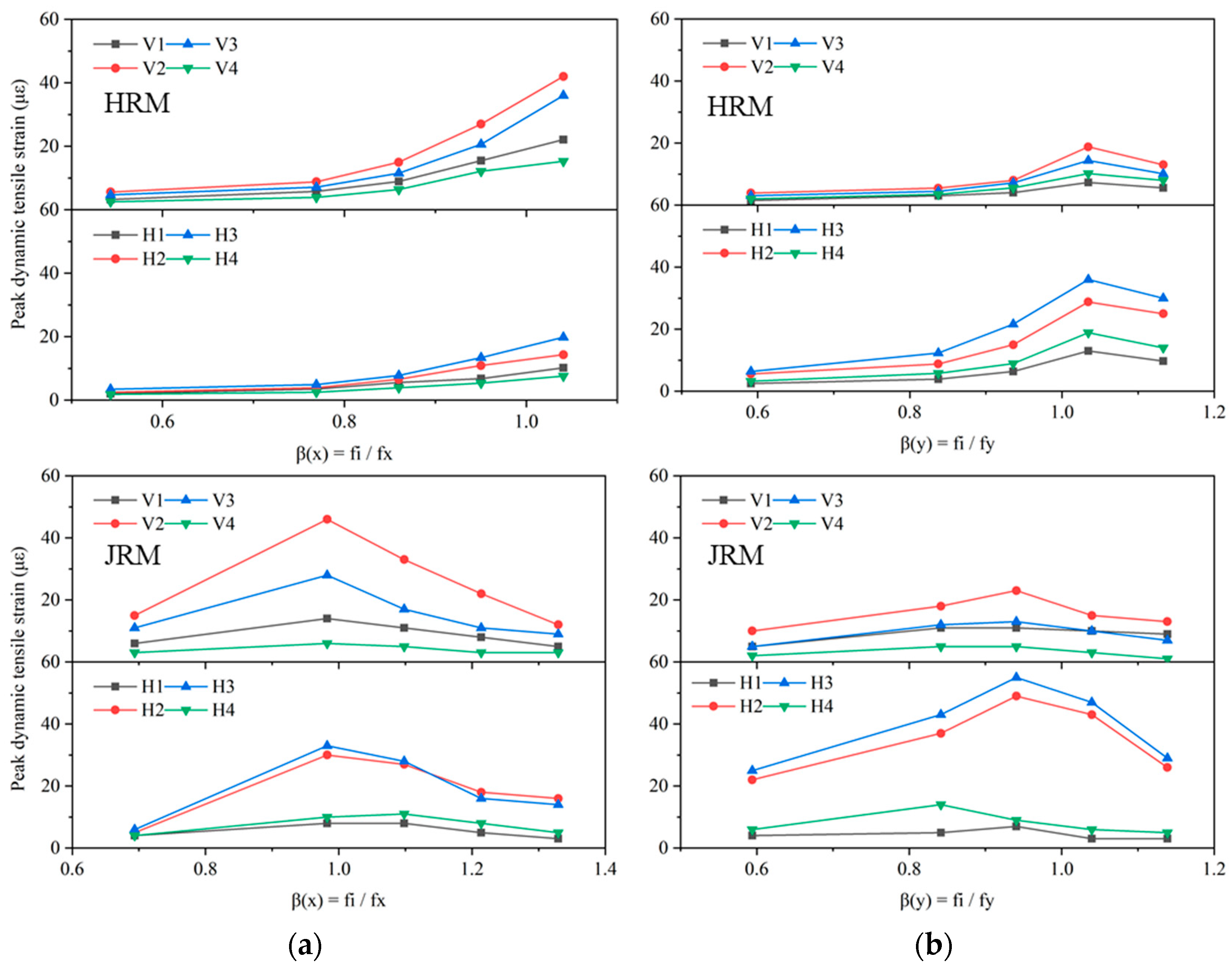
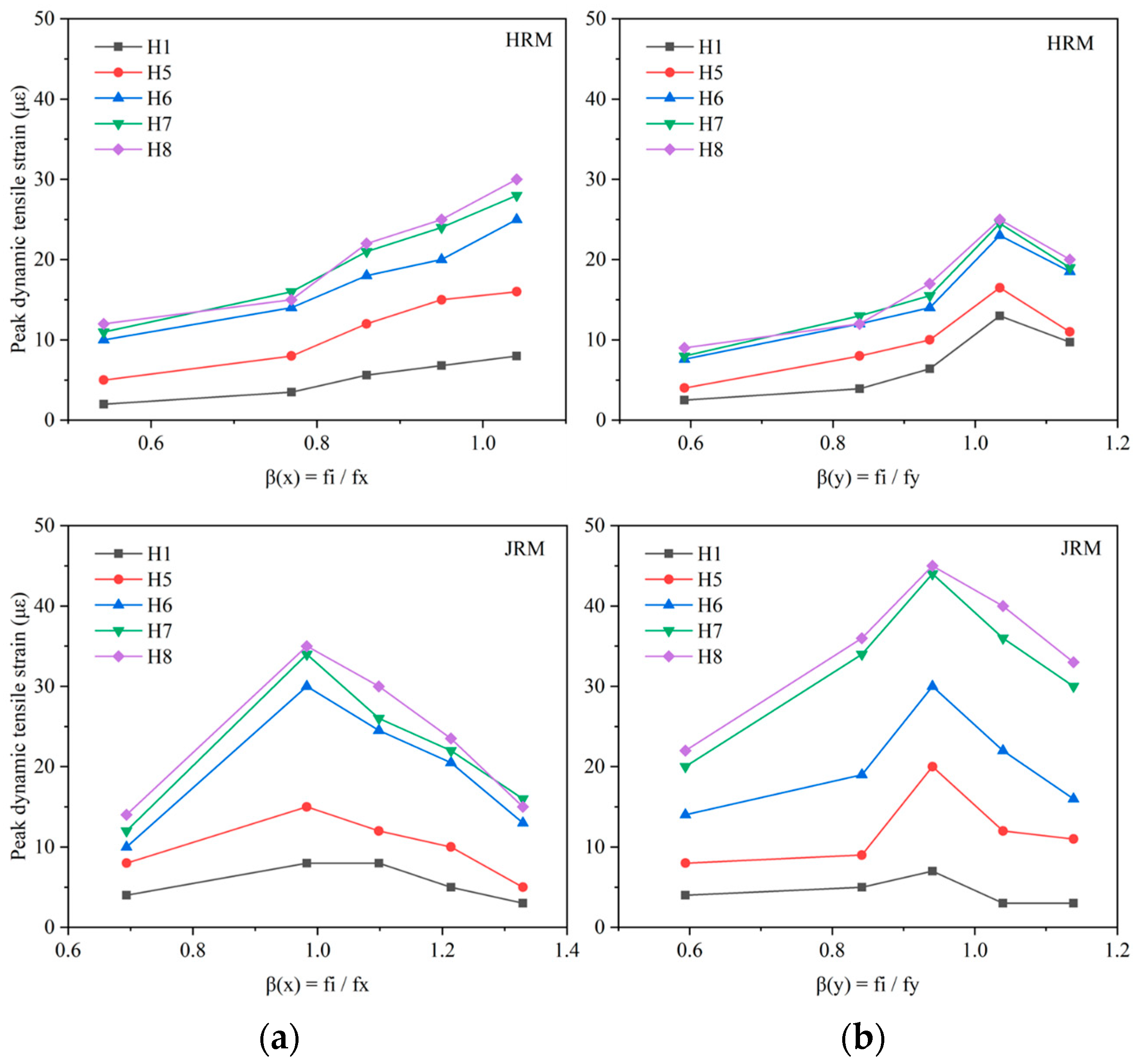
| Item | Expression | Similitude Ratio |
|---|---|---|
| Geometrical | L | 1/30 |
| Density | FT2L−4 | 1/3.33 |
| Young’s modulus | FL−2 | 1/100 |
| Velocity | LT−1 | 1/5.47 |
| Acceleration | LT−2 | 1 |
| Time | T | 1/5.48 |
| Frequency | T−1 | 5.48/1 |
| Strain | / | 1 |
| Stress | FL−2 | 1/100 |
| Item | Density (Kg/m3) | Elastic Modulus (Mpa) | Poisson’s Ratio | Cohesion (kPa) | Friction Angle (°) | |
|---|---|---|---|---|---|---|
| Rock | Prototype | 2550 | 11000 | 0.3 | 1100 | 27 |
| Target | 765 | 110 | 0.3 | 11 | 27 | |
| Test | 730 | 110 | 0.3 | 15 | 33 | |
| Lining | Prototype | 2500 | 33500 | 0.2 | / | / |
| Target | 750 | 335 | 0.2 | / | / | |
| Test | 720 | 350 | 0.2 | / | / |
| Joint Sets | Loading Direction | (°) | λ (m−1) | (m) |
|---|---|---|---|---|
| Sides | x | 90 | 0.67 | 1.27 |
| y | 90 | 0.67 | 1.27 | |
| Faces | x | 15 | 0.64 | 2.42 |
| y | 75 | 0.12 | 3.33 |
| Test Case | Input Motions | Peak Acceleration (g) | Input Direction |
|---|---|---|---|
| WN1 | white noise | 0.05 | xy |
| S12-x | Sine-12 Hz | 0.1 | x |
| S17-x | Sine-17 Hz | ||
| S19-x | Sine-19 Hz | ||
| S21-x | Sine-21 Hz | ||
| S23-x | Sine-23 Hz | ||
| S12-y | Sine-12 Hz | 0.1 | y |
| S17-y | Sine-17 Hz | ||
| S19-y | Sine-19 Hz | ||
| S21-y | Sine-21 Hz | ||
| S23-y | Sine-23 Hz |
| Model | FRF | Hall | Platform | ||||||
|---|---|---|---|---|---|---|---|---|---|
| A1/A2 | A3/A4 | A1/A3 | A2/A4 | A5/A6 | A7/A8 | A5/A7 | A6/A8 | ||
| HRM | 1.38 | 1.45 | 1.11 | 1.18 | 1.23 | 1.40 | 1.07 | 1.22 | |
| 1.45 | 1.39 | 0.98 | 0.93 | 1.06 | 1.21 | 1.01 | 1.15 | ||
| JRM | 1.28 | 1.56 | 0.97 | 1.19 | 1.20 | 1.50 | 1.02 | 1.27 | |
| 1.31 | 1.59 | 0.97 | 1.18 | 1.03 | 1.17 | 1.01 | 1.15 | ||
Disclaimer/Publisher’s Note: The statements, opinions and data contained in all publications are solely those of the individual author(s) and contributor(s) and not of MDPI and/or the editor(s). MDPI and/or the editor(s) disclaim responsibility for any injury to people or property resulting from any ideas, methods, instructions or products referred to in the content. |
© 2024 by the authors. Licensee MDPI, Basel, Switzerland. This article is an open access article distributed under the terms and conditions of the Creative Commons Attribution (CC BY) license (https://creativecommons.org/licenses/by/4.0/).
Share and Cite
Li, R.; Yuan, Y. Effect of Jointed Rock Mass on Seismic Response of Metro Station Tunnel-Group Structures. Appl. Sci. 2024, 14, 4080. https://doi.org/10.3390/app14104080
Li R, Yuan Y. Effect of Jointed Rock Mass on Seismic Response of Metro Station Tunnel-Group Structures. Applied Sciences. 2024; 14(10):4080. https://doi.org/10.3390/app14104080
Chicago/Turabian StyleLi, Ruozhou, and Yong Yuan. 2024. "Effect of Jointed Rock Mass on Seismic Response of Metro Station Tunnel-Group Structures" Applied Sciences 14, no. 10: 4080. https://doi.org/10.3390/app14104080





